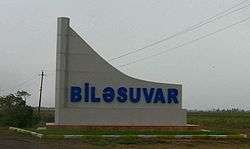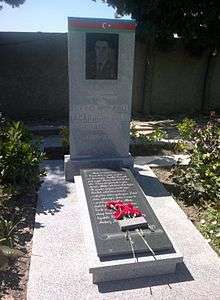Bilasuvar District
Bilasuvar (Azerbaijani: Biləsuvar) - is a rayon of Azerbaijan. Bilasuvar city is its administrative center.[4] There are 26 municipalities.
Biləsuvar | |
|---|---|
 Road sign at the entrance to Bilasuvar Rayon | |
.svg.png) Map of Azerbaijan showing Bilasuvar Rayon | |
| Country | Azerbaijan |
| Capital | Biləsuvar |
| Area | |
| • Total | 1,397 km2 (539 sq mi) |
| Population (2013)[1] | |
| • Total | 94,400 |
| Postal code | 1300 |
| Telephone code | (+994) 25[3] |
Etymology
The district name is derived from city Bilesuvar. Particle “Bile” is derived from the Turkish word “bilya” which means lowland and particle “suvar” means a cavalrymen. According to sources, 10 thousand cavalrymen were deployed in these lowlands by Sassanid shah Khosrov.[5]
Geography
Total area of the rayon is equal to 1358 km2. The rayon occupies the south-western and southern part of the Mugan plain. The territory borders upon Imishli Rayon to the north for a distance of 53 km, Saatly Rayon to the south-west for a distance of 23 km, Sabirabad Rayon for a distance of 20 km, Salyan Rayon to the east for a distance of 23 km and Neftchala Rayon for a distance of 4 km, Jalilabad Rayon to the south for a distance of 54 km, and Iran to the south for a distance of 64 km. The total length of the borders is equal to 241 km.[6]
An international customs post is in the Bilasuvar Rayon territory.
The climate of Bilesuvar is rather hot, with dry summers. Temperature varies from 2 °C (in winter) to 26 °C(in summer) with average rainfall 260mm. Main types of soil in Bilesuvar are chestnut soils, gray meadow, steppe saline soils.
Most of the area of Bilesuvar is below the sea level, 542 hectares of which are forests. Forests include deer, bears, boars, goats, wolves etc.[7]
History
The Persian historian Hamdullah Qazvini wrote that the medieval urban settlement of Bilasuvar was established by the emir of Buveyhi, Pilasuvar in the 10th century, and was hence named after him. In the 14th century, the city declined due to feudal civil strife.[8] The name in Turkic means pure water falls, due to the area's numerous rivers, though given the largely flat terrain the reference to waterfalls is somewhat misleading.[9]
In 1930, Bilasuvar Rayon was created with a center in Pushkin Settlement. In 1938, the rayon was renamed to Pushkin Rayon.[9]
In 1963, the territory was united with Jalilabad Rayon, and in 1964, it became an independent rayon again. After the collapse of the USSR in 1991, it returned to its historic name and was renamed to Bilasuvar Rayon again.
Important historical findings include ruins of Shahriyar-tepe which belong to Middle Ages, the Shakhriyar fortress which was built in Iron Age, Kosha-tepe mound which also belongs to Iron Age. In city Bilesuvar ruins of Icheri Aghdam village and Shahriyar fortress were found. They also belong to the Middle Ages.[7]
Local economy
Bilesuvar is mainly an agricultural region. Main economic activities are livestock breeding, grain, and cotton cultivation. In 2017 41298 heads of large and 138927 of small cattle were registered. Overall, fertile soil amount is 113 thousand hectares, 42.5 thousand of which are sown and remaining are used for pastures. In Soviet-era, 4 state farms were operating in region.[7]
Bunch of agricultural enterprises also operate in the region, such as “LLC Biləsuvar-Aqro”,” Azəryoltikinti” (Asphalt Company), the cotton company "Biləsuvar-Pambıq", etc.[7]
Infrastructure
The district has 9 hospitals with 520 beds, 6 medical clinics, and center for epidemiology, 11 medical centers.[7] Furthermore, district contains 16 post offices.
Population
According to the State Statistics Committee, as of 2018, the population of city was 102,400 persons, which increased by 26,400 persons (about 34.7 percent) from 76,000 persons in 2000.[10] 51,600 of total population are men, 50,800 are women.[11] More than 26.7 percent of the population (about 27,400 persons) consists of young people and teenagers aged 14–29.[12]
| Territory | 2000 | 2001 | 2002 | 2003 | 2004 | 2005 | 2006 | 2007 | 2008 | 2009 | 2010 | 2011 | 2012 | 2013 | 2014 | 2015 | 2016 | 2017 | 2018 |
|---|---|---|---|---|---|---|---|---|---|---|---|---|---|---|---|---|---|---|---|
| Bilasuvar region | 76.0 | 77.0 | 77.9 | 78.8 | 79.9 | 81.2 | 82.5 | 84.0 | 85.4 | 87.1 | 88.7 | 90.3 | 92.3 | 94.0 | 95.6 | 97.4 | 99.2 | 100.9 | 102.4 |
| urban population | 17.6 | 17.9 | 18.1 | 18.3 | 18.6 | 18.9 | 19.2 | 19.5 | 19.7 | 20.0 | 20.3 | 20.6 | 20.9 | 21.2 | 21.5 | 21.8 | 22.2 | 22.6 | 22.8 |
| rural population | 58.4 | 59.1 | 59.8 | 60.5 | 61.3 | 62.3 | 63.3 | 64.5 | 65.7 | 67.1 | 68.4 | 69.7 | 71.4 | 72.8 | 74.1 | 75.6 | 77.0 | 78.3 | 79.6 |
Notable persons
 Mubariz Ibrahimov - Azerbaijani Warrant Officer and National Hero of Azerbaijan
Mubariz Ibrahimov - Azerbaijani Warrant Officer and National Hero of Azerbaijan
References
- The State Statistical Committee of the Republic of Azerbaijan :Biləsuvar rayonu Archived 2012-05-11 at the Wayback Machine:(in azerbaijani)
- Azərbaycan Respublikası Prezidentinin İşlər İdarəsinin Prezident Kitabxanası : İnzibati ərazi vahidləri : Biləsuvar rayonu
- "Şəhərlərarası telefon kodları". Aztelekom MMC. Aztelekom İB. Retrieved 19 August 2015. (in Azerbaijani)
- "Biləsuvar rayonu". Archived from the original on 2012-10-12.
- "AZƏRBAYCAN TOPONIMLƏRIN ENSĠKLOPEDĠK LÜĞƏTI" (PDF).
- "Biləsuvar rayonu". azerbaijan.az. Archived from the original on 2012-07-16.
- Azärbaycan : Azärbaycan milli ensiklopediyası. Aliyev, İlham, 1961-. Bakı: "Azärbaycan Milli Ensiklopediyası" Elmi märkäzi. 2007. ISBN 9789952441017. OCLC 252289725.CS1 maint: others (link)
- "Territorial and Administrative Units" (PDF). preslib.az. Administrative Department of the President of the Republic of Azerbaijan. Retrieved 3 November 2015.
- "Bilasuvar". Authentic Azerbaijan. Archived from the original on 2014-11-11.
- "Political division, population size and structure: Population by towns and regions of the Republic of Azerbaijan". The State Statistical Committee of the Republic of Azerbaijan. Retrieved 2018-12-18.
- "Political division, population size and structure: Population by sex, towns and regions, urban settlements of the Republic of Azerbaijan at the beginning of the 2018". The State Statistical Committee of the Republic of Azerbaijan. Retrieved 2018-12-18.
- "Political division, population size and structure: Population at age 14-29 by towns and regions of the Republic of Azerbaijan at the beginning of the 2018". The State Statistical Committee of the Republic of Azerbaijan. Retrieved 2018-12-18.